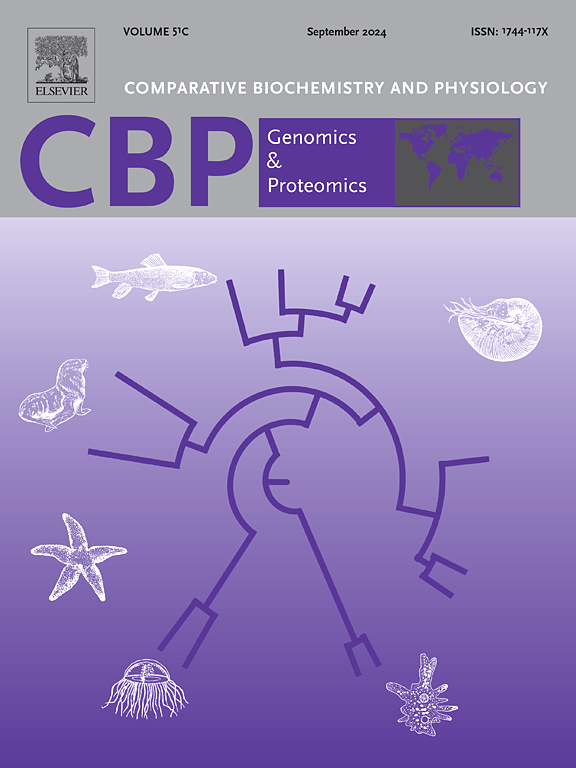Integrated gut microbiota and multi-omics analysis revealed the growth differences of female giant freshwater prawn (Macrobrachium rosenbergii)
IF 2.2
2区 生物学
Q4 BIOCHEMISTRY & MOLECULAR BIOLOGY
Comparative Biochemistry and Physiology D-Genomics & Proteomics
Pub Date : 2025-01-29
DOI:10.1016/j.cbd.2025.101432
引用次数: 0
Abstract
Macrobrachium rosenbergii (giant freshwater prawn; GFP) holds considerable importance in aquaculture due to its high market demand and economic significance. Female GFP growth varies significantly, however, the processes responsible for these growth disparities remain unknown. In this study, intestinal and hemolymph samples of large (FL), medium (FM), and small (FS) female GFPs were collected to investigate the molecular mechanism of female GFP growth. Through the utilization of 16S rRNA sequencing and liquid chromatography-mass spectrometry metabolomics, significant intestinal flora and metabolites linked to the growth performance of female GFPs were identified. The dominant phyla of the three groups were the same, namely Firmicutes and Proteobacteria. Among groups, small females exhibited the lowest abundance of Proteobacteria (27.26 %) and the highest abundance of Firmicutes (70.10 %). The most abundant genus in each group was Lactococcus. Liquid chromatography-mass spectrometry identified 115 annotated differential metabolites, and essential metabolites related to female GFP growth performance were screened. The concentration of serum metabolites in the larger females exhibited a statistically significant variance compared to that of the smaller females. Through association analysis, we identified key genes, metabolites, and gut microbiota that influence the growth of female GFPs. Likewise, we used multi-omics techniques to establish two relationship models (“gut microbiota-GFP phenotype-metabolite”, “gut microbiota-GFP phenotype-transcript”), and three important network association models (“DN5520_c0_g1-CW1-Bacteroides”, “DN537746_c0_g1-BW-Roseburia” and “Picolinic acid-phenotype-Roseburia”) were further developed. The present study provides novel insights into the mechanisms underlying the variability in individual growth among female GFPs. Our findings offer valuable information for future investigations exploring the correlation between gut flora and host organisms in aquatic environments.

求助全文
约1分钟内获得全文
求助全文
来源期刊
CiteScore
5.10
自引率
3.30%
发文量
69
审稿时长
33 days
期刊介绍:
Comparative Biochemistry & Physiology (CBP) publishes papers in comparative, environmental and evolutionary physiology.
Part D: Genomics and Proteomics (CBPD), focuses on “omics” approaches to physiology, including comparative and functional genomics, metagenomics, transcriptomics, proteomics, metabolomics, and lipidomics. Most studies employ “omics” and/or system biology to test specific hypotheses about molecular and biochemical mechanisms underlying physiological responses to the environment. We encourage papers that address fundamental questions in comparative physiology and biochemistry rather than studies with a focus that is purely technical, methodological or descriptive in nature.

 求助内容:
求助内容: 应助结果提醒方式:
应助结果提醒方式:


